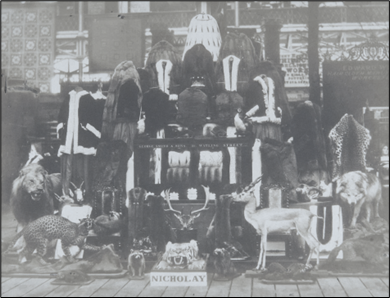
Display of Fur and Taxidermy from the Great Exhibition 1851. Source: Royal Collection Trust.
Elijah was an edge tool maker, beerhouse-keeper and taxidermist. He was an edge tool maker in the 1841 and 1851 censuses, and by 1851 he was married to Charlotte with two children Tom, eight, and a newborn baby Elijah. The beerhouse was the Three Banners on Corporation Street.
In the same year, Charlotte was fined for using ‘filthy and obscene language’. The Sheffield Independent reported that witnesses in the case:
Gave their evidence with becoming modesty and decorum, avoiding even a mention of the gross language alleged … The defendant, on the other hand, uttered before the Magistrate language of the most indecent and revolting description, and not content with the mere mention of this, kept repeating the expressions with a pertinacity which disgusted all who heard them.
This incident is the first evidence of Elijah’s taxidermy business as it occurred when the complainant went to Elijah and Charlotte’s house, ‘To look at a very remarkable calf… which a person in the neighbourhood was stuffing’. In 1857 Elijah was listed in White´s History, Gazetteer and Directory of Derbyshire and Sheffield as one of five ‘Bird &c Preservers’.
The Great Exhibition of 1851 exhibited many stuffed birds and animals and it became very fashionable to have stuffed birds and animals as home decorations. Interestingly The Water Drinkers, a history of the temperance movement, describes possessing a case of stuffed birds as a symbol of the temperance movement as a sign of a thrifty, non-drinking household.
In 1867 the Sheffield Daily Telegraph reported that Elijah was fined £5 for ‘allowing prostitution in his [beer]house on Christmas Eve’ and in 1869 he lost his beerhouse licence because of this conviction.
In the 1871 census Elijah’s occupation was edge tool grinder, although it is possible he was still doing taxidermy as well. Charlotte died in the Ecclesall Union workhouse in 1880 aged 60 and she is likely to have entered the workhouse due to ill-health. In the 1881 census, Elijah was boarding with a family and still working as an edge tool maker. He died in 1885 in the same workhouse. Elijah was interred in an unmarked public grave T 288 and his wife Charlotte in an unmarked public grave MM 106. Both are in the Nonconformist area of the Cemetery.



